- Stone Center
- Blog
Swimming Pool Copings: The Ultimate Buying Guide
1/11/2024
1/24/2022
Swimming Pool Copings: The Ultimate Buying Guide
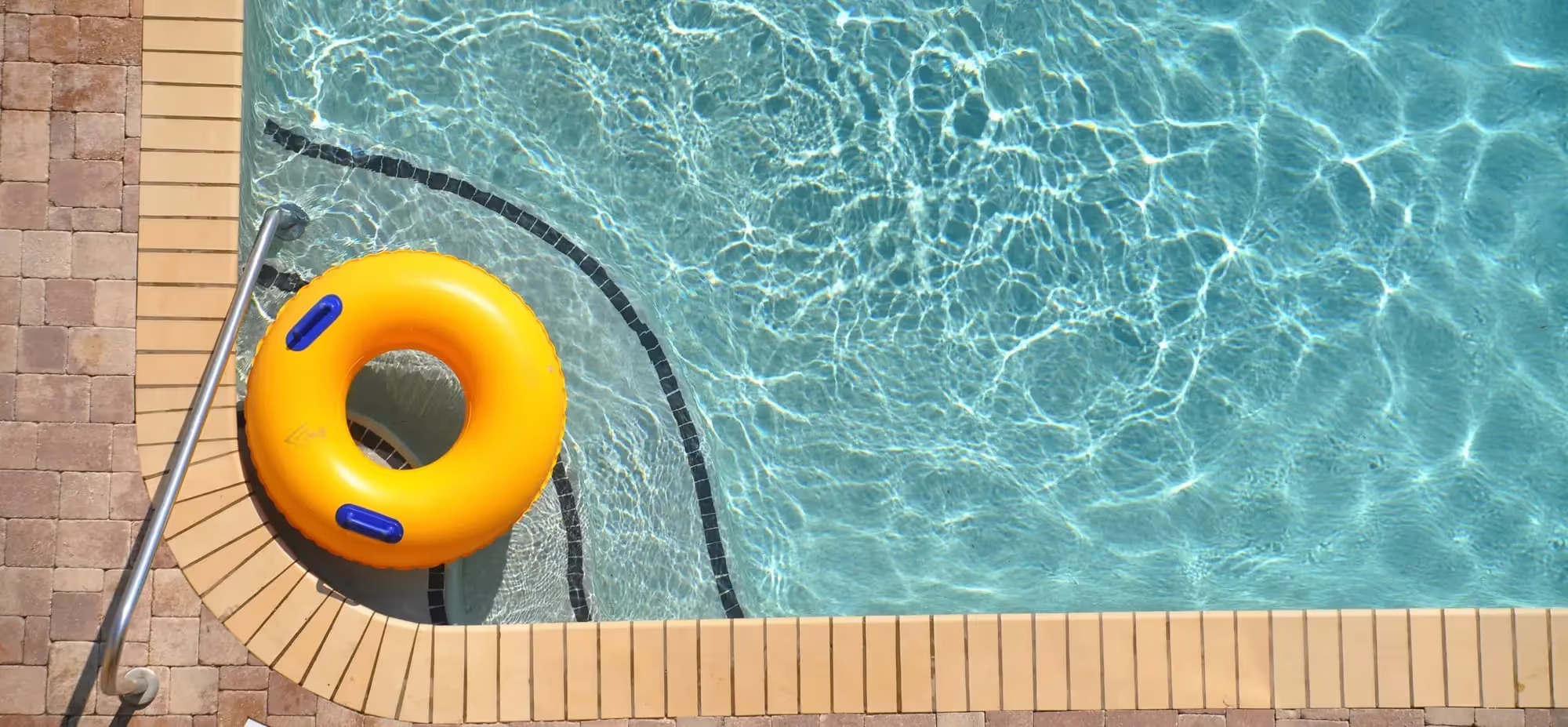
Choosing the right pool coping can be the difference between a stunning, long-lasting pool and one that quickly wears out. Whether you're installing a new pool or renovating an older one, selecting the right material and design for your pool's edge is crucial to its style and longevity. From enhancing safety and durability to boosting the aesthetic appeal of your outdoor space, pool coping is essential for your pool's overall look and functionality.
In this guide, we’ll break down everything you need to know about pool coping, including the most popular materials, edge styles, and key considerations like safety, maintenance, and cost. By the end, you'll be well-equipped to make an informed decision and find the best coping solution for your pool. Our team at Stone Center has outlined everything you need to know about this topic.
What Is Pool Coping? Your Pool's Finishing Touch

Pool coping is the detail that makes all the difference! It caps the edge of your pool where the water meets the surrounding deck, blending beauty and function.
Think of it like the frame around a masterpiece – it provides a finished look and highlights the main event (your pool!). But just like a stylish frame, coping does more than look pretty:
- Protection: Coping acts as a shield, protecting your pool's edges from chips, cracks, and the wear and tear caused by weather, chemicals, and everyday use.
- Safety: A textured coping surface is key for preventing slips and falls around the pool's edge – especially important when things get wet!
- Drainage: Properly designed coping ensures water drains away from the deck, preventing pooling and potential damage to your pool area.
- Beauty: With a wide range of materials, colors, and styles to choose from, pool coping is a major factor in creating your ideal backyard oasis.
To summarize, pool coping does much more than provide a decorative finish; it plays an important role in protecting your pool, enhancing safety, and ensuring water drains properly. With the right coping, you can achieve a stunning pool that balances beauty and functionality for years to come.
Pool Coping Edges
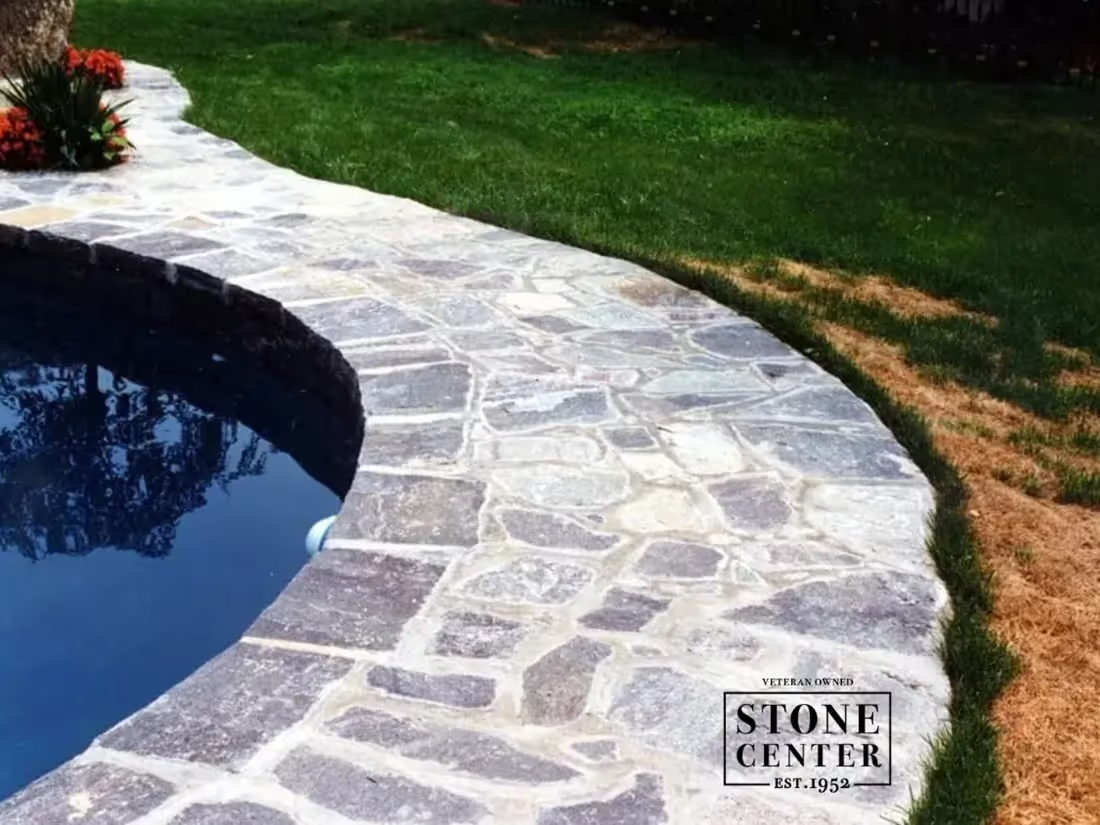
Here are the most popular different types of pool coping to consider before picking your material:
- Top-mount: The most popular style of edging is top-mount, or C-channel, where the edge forms a rounded edge that slopes down, away from the water, and is both functional and comfortable to use.
- Cantilevered: Cantilevered coping, or “square edge” coping, is unique because it uses foam as the finished edge of the concrete. It allows for a seamless blending of the pool deck surface and the pool edge.
- Flat-mount: This type of coping is functional; the track secures the pool liner while forming an installation platform for pavers and stones.
- Rough-cut: A more natural-looking form of pool coping, rough-cut uses stones that are textured and organic.
- Bullnose: Bullnose is one of the most versatile types of pool coping, as it can vary greatly. Bluestone Bullnose coping is a particularly popular choice to achieve any of these styles.
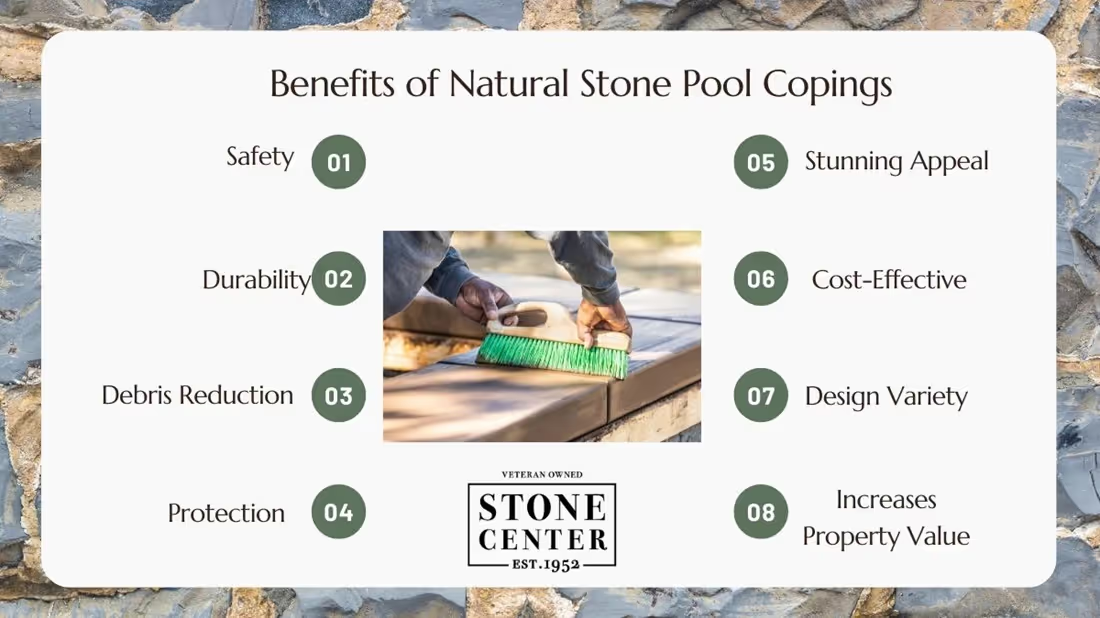
These different edge styles not only offer functional advantages but can also add distinct character to your pool’s design. Depending on your style preference and pool use, each type of coping brings its own set of benefits. Next, we’ll explore the common materials used for pool coping and help you understand which one is best for your needs.
What Are Common Materials for Pool Coping?

When choosing a material for pool coping, always consider factors like durability, aesthetic appeal, maintenance needs, and, of course, budget. Each material offers a unique set of characteristics, so let’s break down what you can expect from each one:
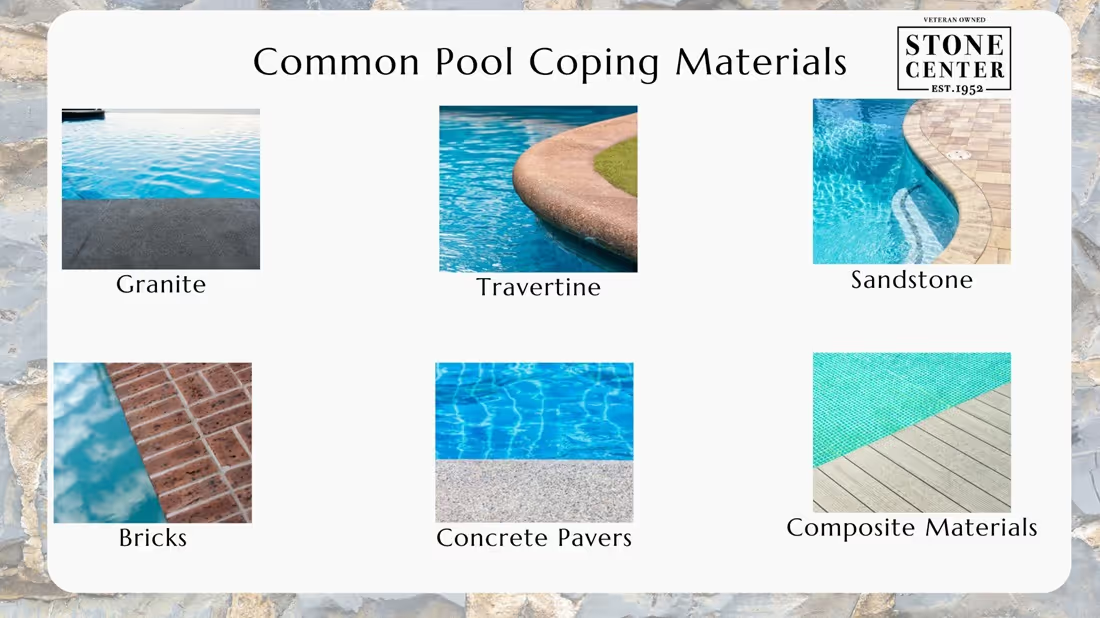
- Natural stones: There’s no better way to make your pool look naturally beautiful than with granite, limestone, sandstone, travertine, or another natural stone. Though flagstone coping costs a little more, it requires very little upkeep and provides a gorgeous look for your backyard pool. These are perfect pool coping materials that provide durability and safety, as they’re usually anti-slip.
- Bricks: Able to withstand chlorinated water, bricks make a versatile and easy-to-access choice for pool coping. They come in a variety of sizes and colors to match your style and can be easily replaced or repaired with a little caulk if they’re damaged.
- Composite materials: Composite materials are easy to adjust, cut, and shape to fit your preferences. This pool edging can be found already available in straight lengths, curved sections, and corners and can be mortared and sealed to create a more cohesive and attractively uniform look. Along with being waterproof and salt resistant, composite materials are also very affordable and durable.
- Concrete pavers: Concrete pavers are an extremely popular choice for pool copings because they don’t need a lot of upkeep, they’re very durable and sturdy, and come in many sizes and finishes. Pavers are also water-resistant and an excellent option for the unique choice of a salt-water swimming pool. The downside is that a concrete deck doesn’t always look as good even though it's equally as expensive as natural stones.
When choosing a material for your pool coping, consider both design and safety. The material should enhance your pool’s look while also offering practical benefits like slip resistance which is extremely important for swimming pools. For example, untextured granite, polished marble, wood, or metal can provide slippery surfaces when wet and pose safety risks. Always prioritize safety alongside design to ensure your pool is both attractive and secure.
How Much Does Pool Coping Cost? Factors to Consider
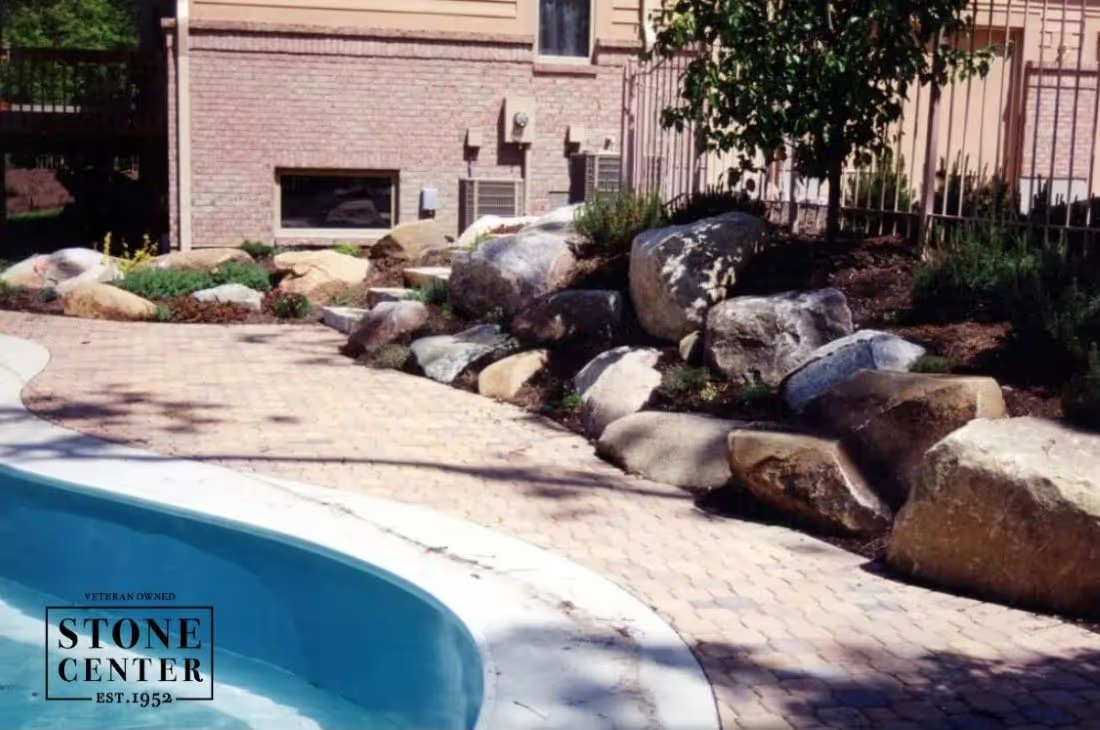
Pool coping is an investment that goes beyond just adding a finished look to your pool — it also impacts long-term maintenance costs and property value. Here's what influences the cost:
- Material Matters: Natural stone offers timeless elegance but comes with the highest price. Composite materials, bricks, and concrete pavers offer budget-friendlier alternatives.
- Quality Counts: Even within each material type, you'll find a range of quality options impacting the cost.
- Design Details: Intricate curves or patterns require more labor and will increase the price compared to simple, straight designs.
- Location & Labor: Installation costs vary by region and the contractor's expertise.
- Size of Your Pool: Larger pools naturally require more materials.
- Pool structure: Curved pools or custom-shaped pools may require more complex coping installation and additional materials compared to simple rectangular pools. Additionally, the depth and size of your pool will impact the amount of coping material needed.
Here's a general breakdown of pool coping costs per linear foot, including installation and pros and cons:
All of these factors play a significant role in the overall cost of your pool coping project. By considering the material, quality, design, and labor costs, you can make an informed decision that balances aesthetics with your budget. Remember, investing in quality coping not only adds beauty to your pool but can also save on long-term maintenance costs, so you can think of it as an up-front investment that will pay for itself over time.
How to Choose the Best Stone for Pool Coping
When it comes to selecting swimming pool coping stones, choosing the right material is crucial. Here are some factors to consider:
- A lip or overhang: Some pool coping options include a C-curve that prevents excess water from leaving the pool and gives swimmers something to hold onto, while other pools just have the right angles.
- Comfort and safety: If you expect the pool to be slippery and fall risk, a rough-textured pool coping will be a safer choice. However, a smoother coping will be more comfortable for sitting on, entering, and exiting the pool.
- Overall pool landscaping: Ensure the pool coping blends or stands out as you prefer in the overall landscape - keeping in mind the patio, walkway, and anything else in the backyard.
- Price: Cost is an important consideration when choosing your pool coping stones. While natural stones may be more expensive than other materials, they offer greater durability and longevity.
- Availability: The availability of the chosen material is also important. Make sure that the stone you choose is readily available in your area to ensure that it can be sourced and installed promptly.
Ultimately, choosing the best stone for your pool coping comes down to your priorities—whether it’s durability, safety, or enhancing the overall look of your backyard. Consider these factors to make a smart, informed decision that meets both your functional and design needs. The result will ensure that your pool remains a stunning focal point of your outdoor space.
Pool Coping Installation
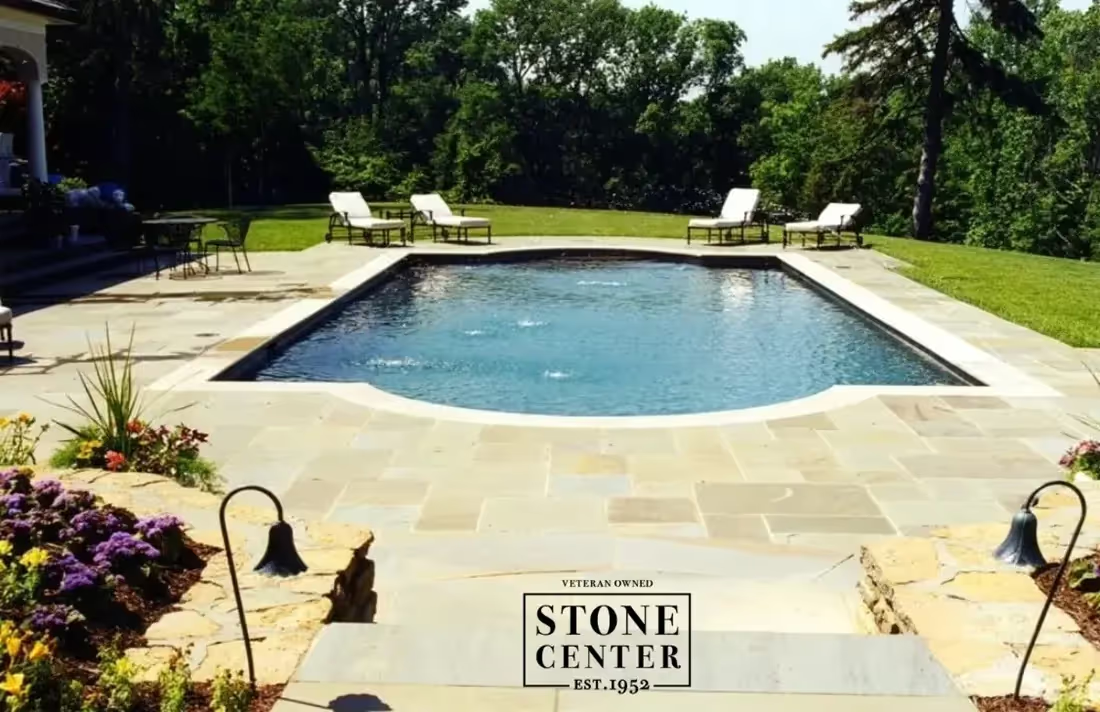
While pool coping installation can be a rewarding project for experienced DIY enthusiasts, this is a job often best left to professionals. Proper installation requires precision and expertise to ensure that the coping is level, that it’s sealed correctly, and that drainage issues are addressed. Any mistakes in installation could lead to costly repairs down the road, so hiring a skilled contractor can help protect the longevity of your investment.
However, if you decide to tackle this project on your own, be sure to:
- Prepare the base and ensure it is level.
- Use proper adhesives for securing the coping stones.
- Allow for proper drainage around the pool edge to avoid water damage.
As a key takeaway, while installing pool coping can be a rewarding project, it’s critical to ensure that the installation is done correctly for long-lasting results. If you’re unsure or want the job done perfectly, hiring a professional can save time and ensure that your pool coping stands the test of time.
Benefits of Natural Stone Pool Copings
Natural stone is often considered the gold standard for pool coping due to its elegance, durability, and timeless appeal. Below, we’ve outlined the top benefits of choosing natural stone for your pool’s edge:
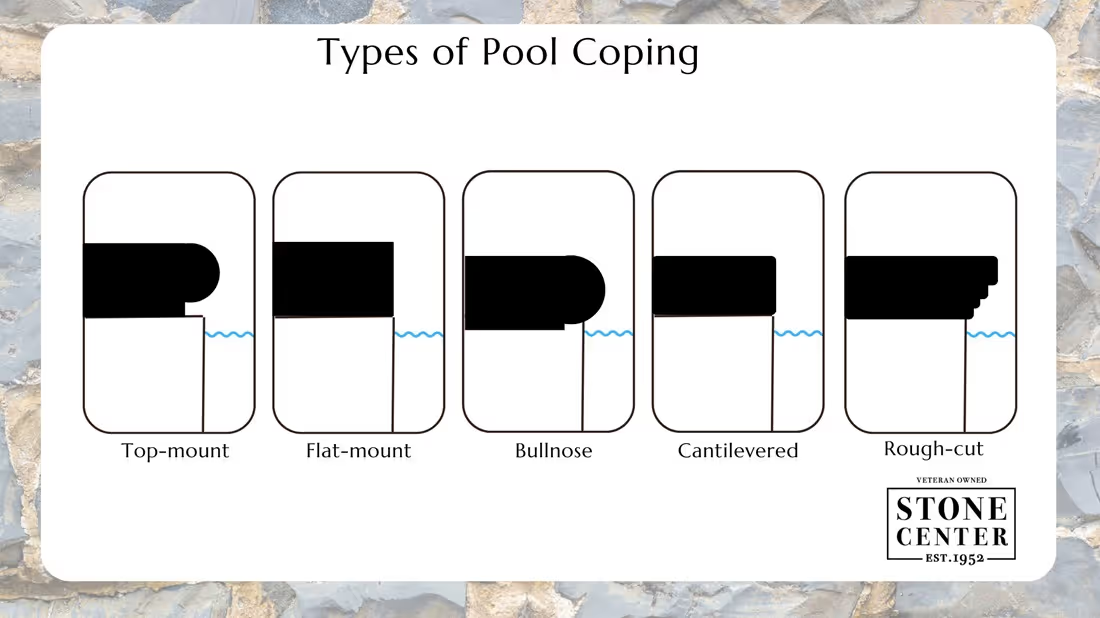
Natural stone coping offers unmatched elegance and durability, making it the ideal choice for homeowners seeking both luxury and functionality. From safety to style, choosing natural stone ensures that your pool remains a beautiful and practical part of your outdoor space for decades to come.
Conclusion
As we’ve discussed, there are some different types of pool edges and various materials that can be used for them. Whether you’re looking for a cohesive look with top-mount, composite coping for your backyard pool, or you're looking to make a splash with natural, rough-cut stones, it’s essential to choose the best pool coping for your specific needs.
We encourage you to keep in mind factors including safety, comfort, pool design, cost, and functionality when making your decisions! If you’re looking for affordable, high-quality swimming pool copings for sale, check out Stone Center! You can visit our website to browse our catalog or contact us directly to learn more about our services and how we can improve your space.
FAQ
.avif)
Jon, the owner of Stone Center, is a knowledgeable expert in natural stone products, specializing in various types of stone for landscaping and architectural projects. Passionate about promoting the beauty and versatility of natural stone, Jon aims to use these blogs to inspire readers with creative ideas to upgrade their homes.
How much does it cost to get a stone restored?
How much you end up spending to restore stone varies on the type of stone, the technique, and the stone’s current condition. Stone in good condition will cost less to restore, whereas stone that has a lot of wear and tear may require a longer restoration.






.jpg)
%20(1).avif)
.avif)
.avif)
.avif)
